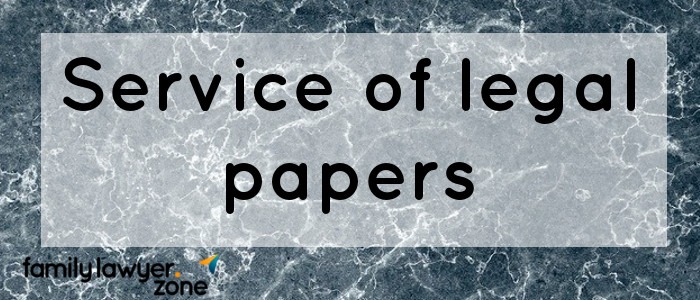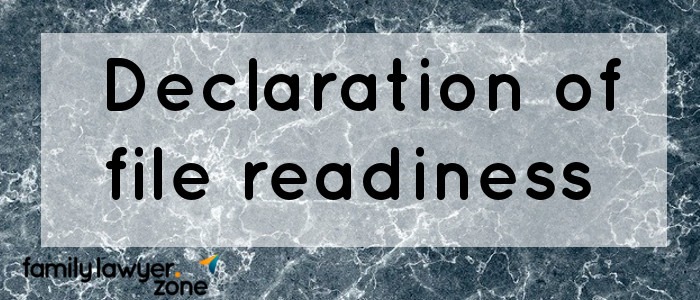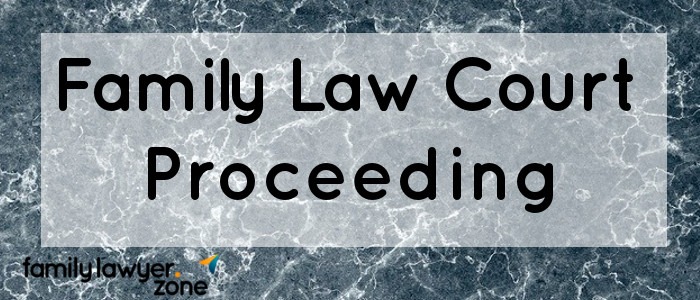Court proceeding
What are the different stages in a family law court proceeding?
Ever wondered what are the different stages in a family law court proceeding like a divorce case, dissolution of legal proceeding or legal separation?
You’ve filed for a divorce or got served with court papers and now wondering what are the next steps in your family law legal journey?
In this article, we will look over the different stages in a family law court proceeding from the filing of a court application all the way to the rendering of a final judgment.
A typical family law court proceeding will generally involve nine steps or milestones to achieve a final judgment and these steps are:
- Filing of the court demand
- Service of legal papers to defendant
- Initial presentation of the case at court
- Filing of a case protocol
- Safeguard orders
- Provisional orders
- Declaration of file readiness for trial
- Trial on merits
- Judgment from the court
- Conclusion on family court proceedings
Keep reading as we will go into each of these steps in more detail.
1. Filing of the court demand

The first step in a family law court case is the filing of a demand.
In Quebec, in legal jargon, we refer to this as a “demand originating proceedings”.
For example, if you intend on filing a divorce application, then you must draft a divorce application in accordance with the rules of procedure if the Court.
When your divorce application is ready, it must be “filed in court”.
Filing in court is simply depositing the original version of your divorce application in the records of the court and getting a court file number attributed to your case.
The final formality in the initial filing of your court application is to pay a court filing fee, or court costs, associated with the type of application you are filing.
The court cost will be confirmed to you by the court clerk situated at your local courthouse.
Generally speaking, the above process applies to most legal applications or demands filed before the courts in Quebec in family law, such as legal separation, dissolution of a civil union, child support or child custody applications.
2. Service of legal papers to defendant

Once you have deposited the original of your court application in the record of the court, paid your court stamp and obtained your court file number, or docket number, you are ready to serve your papers to the other party.
The service of legal papers is a process by which you will send a certified copy of your court papers to your former spouse or defendant and obtain proof that he or she in fact received the papers.
The service of your court documents will be initially done by a bailiff, or a process server as it is generally called in common law jurisdiction.
The bailiff is a professional tasked with the mandate of delivering your court papers to the defending party and providing a report of the date, time, place and name of the person who received the court papers.
The facts and statements made by the bailiff with respect to the actual service is admitted in court without much objection as such document is legally considered an authentic act.
The legal papers you send the defendant must contain a summons.
The summons is the document that legally calls the defendant to take an action in response to the lawsuit served and such action is defined by law as follows under article 145 of the Civil Code of Procedures of Quebec:
The plaintiff summons the defendant before justice by means of a summons attached to the application. The summons includes a list of the exhibits in support of the application and informs the defendant that they are available on request.
The defendant must answer the application within the following 15 days, failing which a default judgment may be rendered and the legal costs awarded against the defendant.
The defendant must respond within fifteen days from the receipt of the summons and disclose his or her intention to negotiate a settlement or establish a case protocol for the orderly progress of the legal proceedings.
Failure to respond within fifteen days, the plaintiff may request from the court the rendering of a default judgment which is something the defendant can easily avoid.
3. Initial presentation of the case at court

Now you are advancing your lawsuit journey.
You have successfully served your former spouse or defendant.
So what’s next?
The next step is for the initial presentation of your court case before a judge.
This initial presentation is not a date where a judge will render a final judgment on your case but a date where the court demands that the plaintiff and defendant agree on a case protocol.
At the initial presentation of the case, the judge will have the role of a coordinator as opposed to a trial judge.
The judge will see, in summary fashion, the nature of the dispute and what the parties intend to do in light of preparing the case for readiness to be heard by a trial judge.
The judge will ensure that what the parties ask is reasonable and proportionate in consideration of the nature of dispute, sums involved and overall complexity of the file.
4. Filing of a case protocol

A case protocol, as its name suggests, is a timetable of different activities that each party wants and is authorized to perform, directly or through their lawyers, and the various milestones legally required to be satisfied so that a legal case is declared to have the readiness to ultimately go to trial.
The law defines the case protocol as follows:
The parties are required to co-operate to either arrive at a settlement or establish a case protocol. In the case protocol, the parties set out their agreements and undertakings and the issues in dispute, indicate the consideration given to private dispute prevention and resolution processes, describe the steps to be taken to ensure the orderly conduct of the proceeding, assess the time completing these steps could require and the foreseeable legal costs, and set the deadlines to be met within the strict time limit for trial readiness.
The novelty of the case protocol in Quebec is that the lawyers and the parties must assess the foreseeable legal costs associated with the completion of each legal step required.
For example, if a party demands to obtain an expert’s opinion, then, the foreseeable costs associated with that must be disclosed.
The main reason why the law requires a case protocol to be implemented to govern the proceedings is to ensure that the parties are accountable to do what’s needed within a specified timeline and that the file harmoniously progresses and is ready to be tried.
Ideally, the parties themselves will agree on the content of the case protocol and file the mutually signed version in the record of the court.
However, in cases of disagreements, the parties will then submit their sources of contention and arguments to the court and the judge will decide on the matter.
We typically refer to this as “case management”.
5. Safeguard orders

In family law cases, safeguard orders may be very important if not crucial in dealing with a highly urgent matter that must be resolved immediately.
A safeguard order is an urgent demand made by one party in a court proceeding to request assistance from the court in dealing with an urgent matter that cannot wait until the trial date in many months or years.
For instance, a spouse may file for divorce and at the same time immediately ask for a safeguard order with respect to parenting rights, parenting time and child support as the ex-spouses cannot agree on these topics to the detriment of the children.
This will be the case when the spouses are in dispute regarding who will keep custody of the children and who should pay for the children’s expenses.
Imagine if you don’t work and you depended on your spouse to pay your children’s expenses and school fees, and if payment is not made in the next few weeks, your child will be deprived of his or her education, then this is a scenario that will warrant filing for a safeguard order.
Safeguard orders can be essentially on any topic of important urgency and where an irreparable harm may be caused if the court does not render and immediate judgment.
6. Provisional orders

While safeguard orders are valid for a very short period of time and are intended to provide remedy for a highly urgent matter in the immediate, provisional orders are a type of judgment that will govern the parties for the entire duration of the legal proceedings.
A typical contested divorce case or legal separation case can take potentially two to three years to complete.
As a result, if you have to take care of your children and continue paying for the family expenses, take care of the family residence and do many activities to transition out of your relationship, a provisional order is useful to ensure that you and your ex-partner have clarity on your obligations so to avoid further dispute.
A provisional order will generally cover the parenting obligations, child support, spousal support and use of family assets like the family residence, furniture and so on.
The provisional order is not intended to deal with matters such as partition of assets and the accessory measures to a divorce, legal separation or dissolution of civil union.
Such legal matters will be dealt with by the trial judge at the final hearing on merits.
In most cases, when a divorce application or legal separation application is filed, a motion for provisional measures will also accompany the main application.
In fact, the defendant will receive two motions, the divorce application along with a motion for provisional measures.
In this instance, the divorce application will deal with the spouse’s demands on the merits of the case and the provisional motion will seek to obtain a judgment on the important matters for the duration of the proceedings.
7. Declaration of file readiness for trial

When all the legal tasks and activities are performed to the satisfaction of the parties and to the extent authorized by the court as per the case protocol, the parties must eventually declare the file ready to proceed to trial.
This declaration of file readiness is important as the court will review the file and ensure that all the exhibits, documents and material that the parties wish to present to a judge have in fact been filed and disclosed to the other party.
When you declare your file as ready for trial, this means that you have gathered all the evidence that you need, like documents, contracts, e-mails, written statements, you have done any expertise or obtained expert evaluations and reports, like accounting expertise, property evaluations, psychosocial evaluations or other, and you have done any out of court examinations that was needed for your case.
When declaring the file ready, the parties must also disclose the name of witnesses they intend on calling to trial, disclose the nature of their testimony along with how long each party anticipates examining and cross-examining each witness.
With this assessment, the court can estimate the number of days needed for trial before a judge and eventually book you for trial.
8. Trial on merits

You have now reached the stage where you must proceed to the trial on the merits of your case.
You may have waited six months, two years, four years or maybe longer to get to this point.
The trial day is a significant date as it is the day where each party will expose their case, present their evidence to the court and provide their pleadings to the judge in an attempt to sway the decision of the judge in their favor.
The success of the trial on the merits will depend on many factors that go beyond the documents and evidence filed in the record of the court.
From our perspective, half of the battle is fought in the several years leading to the trial date but the other half, which is quite significant, is fought in the several days of trial that you have been given to present your case and convince a judge of your position.
If you are successful in trial, even if your case may not have been a home run on paper, you increase the likelihood of your overall success.
The reverse is also true.
You may have a good case on paper but due to a poor performance and inadequate preparation for trial, you may walk away highly disappointed.
9. Judgment from the court

When you have presented your case to the judge during trial, all the witnesses heard, all exhibits presented to the judge and each party’s plea heard by the judge, the court will then consider all the facts and legal argumentation to render a judgment.
In most cases, when a judge hears a case on the merits, the judge will take the case under advisement and render a judgment at a later point in time.
Judges have up to six months to render their judgment once trial is over.
When the court deals with safeguard orders, the court’s decision will generally be rendered on the bench.
With regards to provisional judgments, in most cases, the judge will render a decision at the end of the hearing and will orally read his or her judgment that will ultimately be drafted and sent to the parties.
With regards to a judgment on the merits, when the judgment is rendered, that decision will put an end to the legal proceedings in the first instance.
The first instance is the first court that was seized with the legal application.
For instance, if you intend on filing a divorce, the first instance court is the Superior Court of Quebec in the province of Quebec as that’s where the initial divorce application will be filed.
If the judgment on the merits is not appealed within thirty days of it being rendered, then the legal case is definitively resolved and closed.
The judgment on merit will be sent to your lawyer if you are represented and sent by mail if you are self-representing.
10- Conclusion on family court proceedings
In this article, we wanted to share with you the typical court process when dealing with a family law case such as a divorce, legal separation or dissolution of civil union.
We hope this article was informative for you.
Should you need any further information, need legal representation or legal advice, we invite you to contact our law firm dedicated to family law cases.
We can support you with your court process and legal proceedings to ensure that every step of your case is handled with care and diligence so that you put all the chances on your side.
We look forward to working with you.
Alternatively, we invite you to continue reading the great resources and legal information we make available to you and our clients through our website.
FamilyLawyer.Zone



